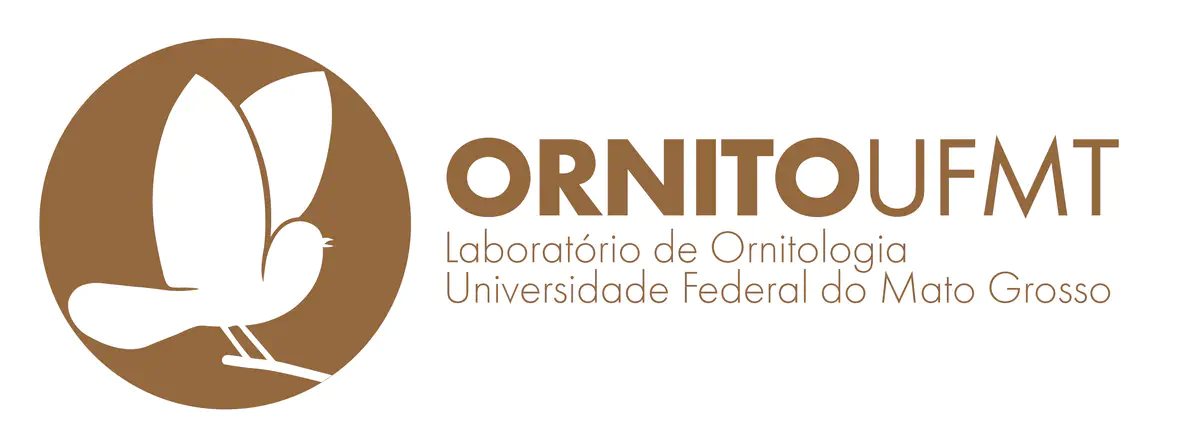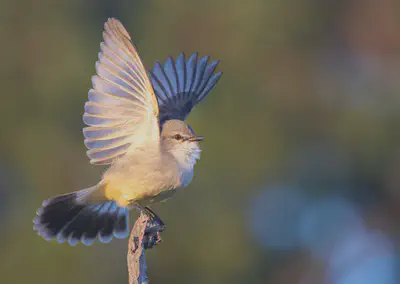Welcome. And what is the bird in the logo?
This is the inaugural post of our Ornithology Lab website, or simply OrnitoUFMT / Piacentini Lab. As such, I thought it best to start by explaining the logo. After all, what bird is represented in it and why was it chosen?

This is the inaugural post of our website – OrnitoUFMT / Piacentini Lab. As such, I thought it best to start by explaining the logo. After all, what bird is represented and why was it chosen?
The logo is a six-hand creation, based on a general concept of mine and with guidance from Renato Rizzaro (from Roda de Passarinho), whom also suggested the fonts, and other orientations and final execution by Júlia Montesanti.
And what bird would that be? There is in the Cerrado a bird that makes a very characteristic and diagnostic display, raising both wings while singing, which is the Chapada Flycatcher, scientific name Guyramemua affine. And why did I choose this species for the logo? Simple: for all its history in ornithology!

Until the turn of the century this species was not even recognized as such. The Chapada Flycatcher is morphologically very similar to the central-northern, yellow-bellied populations of Suiriri Flycatcher, with which it co-occurs, and the two species were treated as one. But some ornithologists rightly noticed that there were two patterns of voice and behavior, and that individuals who had one of the patterns did not recognize (and did not respond to) the other pattern, indicating that they were two distinct species. Thus, in 2001, a taxonomy work was published, based especially on bioacoustics and behavior data, describing the Chapada Flycatcher as a new species for science, named Suiriri islerorum. And the “typical homeland” of the new species (that is, the place where the specimen that serves as a scientific reference for the new species comes from) is on the outskirts of Cuiabá [our headquarters!], more precisely at Chapada dos Guimarães. The extreme morphological similarity, in a possible case of mimicry, prevented the species from being recognized before, even though today we know that there was already material from the Chapada Flycatcher available in museums and scientific collections, from more than a century ago .
By the way, it was even recently discovered that among these previously unrecognized specimens of the Chapada Flycatcher there were two that served as the basis (the “syntypes”) for the description of a new taxon in 1856, named “Elaenea affinis” [ subsequently recognized as being of the genus Suiriri]. By mistake (as a result of the morphological similarity), the then new bird was not recognized as a species distinct from the yellow-bellied Suiriri and, after a revision in 1955, its name was treated as a subspecies of the Suiriri Flycatcher. However, by the rules of zoological nomenclature, as we now know that the affinis and the islerorum were described based on individuals belonging to the same species (different from the Suiriri), the valid name of this distinct species is the oldest among them. And that’s why, as of 2014, with the disclosure of these facts, the scientific name of the Chapada Flycatcher changed to Suiriri affinis.
It’s complex and not very linear, but what’s worse is that the confusion didn’t stop there. My colleague and friend Leonardo Lopes, who has become one of the greatest experts in the biology of the Chapada Flycatcher, decided to evaluate the evolutionary history of the species based on molecular data. And what he discovered is that, contrary to initial understanding (with the recognition of two species in 2001), the two Cerrado flycatchers are not directly related. More than that, they don’t even belong to the same bird subfamily! The results of the genetic analyses showed that the Chapada Flycatcher is therefore a very distinct lineage and, in order to accommodate this within a coherent biological classification, Lopes and collaborators published in 2017 a systematic work proposing a new genus for the species: Guyramemua, which etymologically means “the bird that deceives” [ornithologists]. Since then, and incorporating yet another nomenclatural detail (of gender agreement!), the scientific name of the Chapada Flycatcher has become Guyramemua affine!
Summarizing it all: specimens of the Chapada Flycatcher were represented in scientific collections since at least the middle of the 19th century, including the types of the name affinis, but by mistake it was imagined that they were all just specimens of the yellow-bellied population of the Suiriri Flycatcher. In 2001, it was demonstrated that there were two species with distinct songs and behavior among the yellow-bellied birds, with the Chapada Flycatcher (re)described as a new species, when in fact those who needed a new name were the yellow-bellied Suiriri Flycatcher, which have always been (mistakenly) called affinis. The error in applying the name affinis was corrected in 2014, but it was only in 2017 that the evolutionary relationship between the two species was resolved, culminating in the scientific name Guyramemua affine.
We see, in conclusion, that the geography and ecosystem of the Chapada Flycatcher, evidenced in the paragraphs above, are directly linked to the place and biome where our laboratory is located. And the recent history of this species involves works that deal with the main lines of research and methods (in bold throughout the text) worked by me and by the students of our still-new Piacentini Lab (and even secondary themes that I have worked on, such as mimicry, also appear in the history of the species).
Bibliografia de apoio
Kirwan, G.M.; Steinheimer, F.D.; Raposo, M.A.; Zimmer, K.J. (2014). Nomenclatural corrections, neotype designation and new subspecies description in the genus Suiriri (Aves: Passeriformes: Tyrannidae). Zootaxa 3784: 224–240.
Lopes, L.E.; Chaves, A.V.; Mendes de Aquino, M.; Silveira, L.F.; dos Santos, F.R. (2017). The striking polyphyly of Suiriri: convergent evolution and social mimicry in two cryptic Neotropical birds. Journal of Zoological Systematics and Evolutionary Research 56: 270–279.
Zimmer, K.J.; Whittaker, A.; Oren, D.C. (2001). A cryptic new species of flycatcher (Tyrannidae: Suiriri) from the Cerrado Region of Central South America. The Auk 118: 56–78.